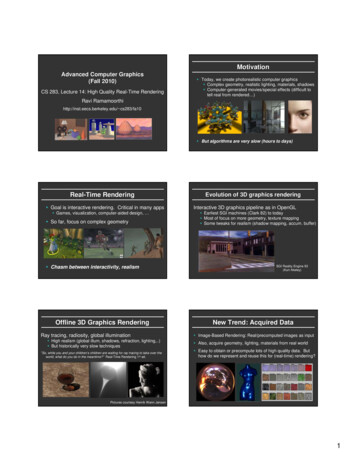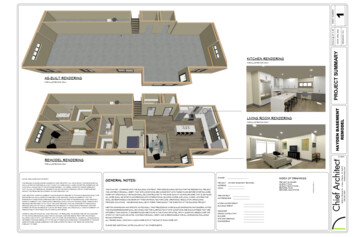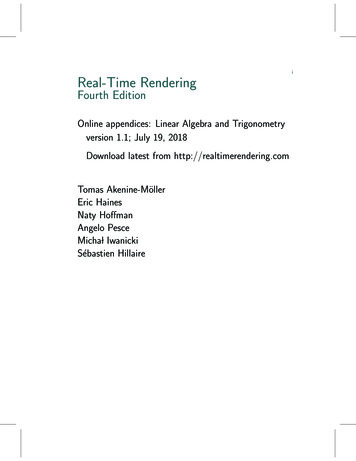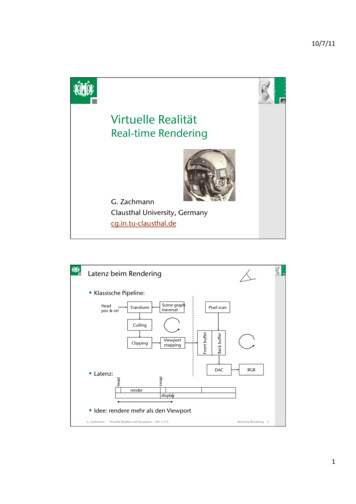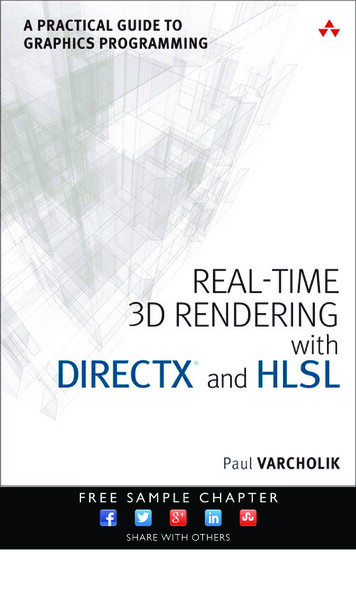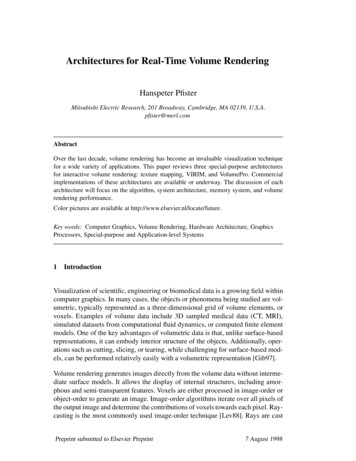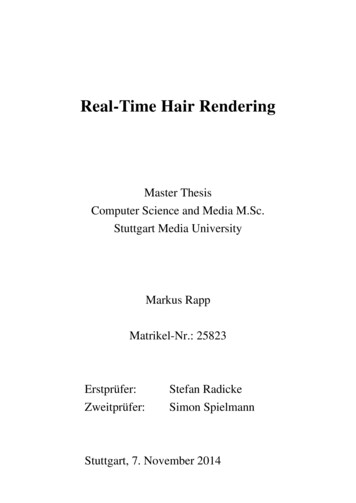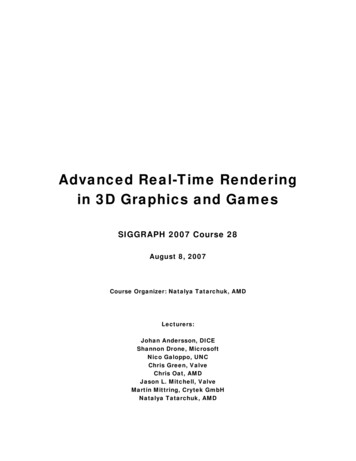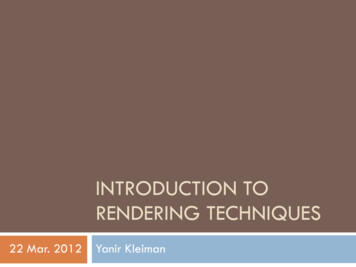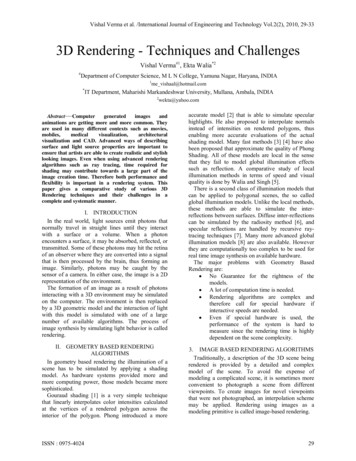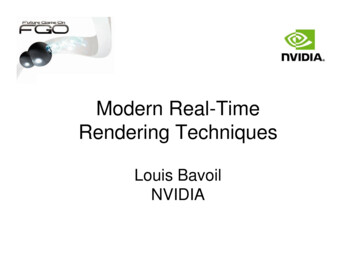
Transcription
Modern Real-TimeRendering TechniquesLouis BavoilNVIDIA
Outline Practical real-time rendering algorithms for:– DirectX 11 Tessellation– Transparency Particle Rendering Order Independent Transparency– Post-Processing Effects Screen Space Ambient Occlusion Depth Of Field
DirectX 11 Tessellation
Geometric Detail in Games Pixels are meticulously shaded– But geometric detail is modest
Geometric Detail in Films Pixels are meticulously shaded– And geometric detail is substantial Dynamic tessellation displacement mapping– Defacto standard for film rendering– Enables richer content and animation
Displacement MappingInput control cageAfter tessellation Kenneth Scott, id Software 2008After tessellation displacement mapping
DX11 Tessellation PipelineVertex Hull shader– Runs pre-expansion– Input 1 patch (control points)PatchAssembly Domain shader––––Runs post-expansionInput 1 tessellated vertexCan perform displacement mappingCan shade at intermediate frequencybetween vertices and pixelsHullExpandsgeometryon the GPU Fixed-function tessellation stage– Configured by LOD output from hull shader– Produces triangles or linesTessellatorDomainPrimitiveAssemblyGeometry
DX11 Tessellation Benefits Memory footprint & bandwidth savings– Store coarse geometry, expand on-demand– Enables higher geometry throughput Computational efficiency– Dynamic Level Of Detail (LOD)– Animate coarse geometry pre-expansion Scalability– Dynamic LOD allows for performance/quality tradeoffs– Scale into the future – resolution, compute power
DX11 Tessellation On/OffUnigine Corp. 2005-2010. All rights reserved
Tessellation in Metro 2033Displacement mapping enables filmlevel geometric complexity in real-timeScreenshots from Metro 2033 THQ and 4A Games
More Tessellation Use Cases
Tessellation Algorithms For subdivision surfaces– “Phong Tessellation”[Boubekeur and Alexa 08]– See GDC 2010 slides[Ni 10] For hair strands– See SIGGRAPH 2010 slides[Tariq and Yuksel 10] THQ and 4A GamesPhong Tessellation
Hair Video18,000 rendered strands on the GPU from a few 100 simulated strands
Grass Video
Island Video
Particle Rendering
Rendering Particles Particle camera-facingquad with texture– Useful for rendering smoke,steam, snow, waterfalls, etc Typically bottlenecked byraster ops or pixel shading– Possible optimization low-resolution rendering Square EnixFrom Batman: Arkham AsylumBATMAN: TM & DC Comics.(s10)
Low-Resolution Particles Render particles into offscreen low-res render target– E.g. half or quarter resolution Need to perform depth testagainst opaque depth buffer– In the pixel shader– And/or using a downscaledhardware depth bufferFull-res particles Main issue: blocky artifactsdue to low-res depth testLow-res particles[Cantlay 07]
Fixing Blocky Artifacts Downscale depths using a max filter– Helps but doesn’t remove all z-test artifacts Mixed resolution rendering– Can fix all artifacts– But refinement pass is expensive Joint Bilateral Upsampling– Can use a 2x2 kernel with Spatial weights bilinear weights (hard coded) Range weights exp(-σ.(zhalfres – zfullres)2)– May cause artifacts for island pixels If all weights are close to zeroLow-res particles[Cantlay 07][Kopf et al. 07][Shopf 09]
Nearest-Depth Filter 2x2 upsampling filter used in Batman: Arkham Asylum– For the low-resolution particles (half-res and quarter-res) Step 1: fetch linear depths– Fetch the full-res depth zc at center uvc– Fetch the nearest 2x2 low-res depths zsample– For each sample, keep track of uvmin with minimum zsample – zc Step 2: fetch low-res color– If zsample – zc ε for all samples Then fetch low-res texture with bilinear filtering at uvc Else fetch low-res texture with point filtering at uvminBATMAN: TM & DC Comics.(s10)
Shadowing Particles Particles can – Receive opaque shadows From opaque objects usingregular shadow mapping– Cast and receive volumetricshadows from particles With Fourier Opacity MappingFourier Opacity Mapping[Jansen and Bavoil 10] Fourier Opacity Mapping (FOM)– Used in Batman: Arkham AsylumBATMAN: TM & DC Comics.(s10)
FOM Video
Order Independent Transparency
Alpha Blending Alpha Blending– Useful for rendering alpha-blended vegetation, semitransparent objects, etc.– Requires depth-sorted order Back to front or front to back Sorting triangles– Can be expensive to do for all triangles– Not correct if triangles intersect one another
Depth Peeling Depth peeling and dual depth peeling– Captures color layers in depth-sorted order– Blends layers on the flyFirst layerSecond layer[Everitt 01][Bavoil and Myers 08]
A-Buffers A-Buffer list of fragments per pixel [Carpenter 84] Approach: capture all the translucent fragments inrasterization order, not in depth order– Stencil-Routed K-Buffer [Myers and Bavoil 07]– Per-Pixel linked Lists [Gruen and Thibieroz 10]– CUDA rasterization [Liu et al. 10] Issue: video memory– Need to store all the fragments before processing them
Stochastic Transparency Stochastic Transparency [Enderton et al. 10]– Extension of alpha to coverage– Pros: No sorting needed, naturally works with MSAA– Con: Noisy outputWith 8 MSAA samples per pixel
k-NSS k-NSS k Nearly-Sorted Sequences– Used for volume rendering of tetrahedral meshes [Callahan et al. 05] [Bavoil et al. 07]– Hybrid algorithm Object space: Sort triangles by centroid depth Image space: Reorder fragments in a sliding window of size k– Assuming that fragments are no more than k out-of-order– Pixel shader outputs nearest or farthest fragment from k-buffer– Fragments are blended on the fly using fixed-function alpha blending With DX11 ps 5 0 pixel shaders– Can implement k-NSS fragment sorting Using InterlockedMin in pixel shader Similar to “multi depth test” from [Liu et al. 10]
Screen Space Ambient Occlusion
Ambient Occlusion (AO) AO can be defined as the fraction of sky seen from each point Gives perceptual clues of curvature and spatial proximityWithout AOWith AO
SSAO SSAO Screen Space Ambient Occlusion Approach introduced concurrently by– [Shanmugam and Orikan 07]– Crytek [Mittring 07] [Kajalin 09] Post-processing pass– Use depth buffer as representation of the scene– Can multiply SSAO over shaded colors
HBAO HBAO Horizon-Based Ambient Occlusion– SSAO algorithm developed by NVIDIA– [Bavoil and Sainz 08] [Bavoil and Sainz 09] Normal-Free HBAO––––“Low Quality” mode in DX10 SDK SSAO sampleInput view-space depths only (no normals needed)Integrates AO in the full sphereUsed in Battlefield: Bad Company 2 [Andersson 10]
With and Without NormalsHBAO with normalsNormal-Free HBAO
HBAO OFFFrom Battlefield: Bad Company 2 EA/DICE
HBAO ONFrom Battlefield: Bad Company 2 EA/DICE
HBAO Performance Typical parameters– Normal-free HBAO pass Half-res, 8x6 depth samples per AO pixel Max footprint width 5% of screen width– Blur passes (horizontal vertical) Full-res, fetch packed (ao,z) Blur radius 20 pixels to remove flickering– MSAA disabled for SSAO passes SSAO aliasing is rarely objectionable Typical 1920x1200 performance on GeForce GTX460– Total HBAO cost 5 ms 2.3 ms for occlusion pass 2.8 ms for blur passes
Other SSAO Algorithms “Crytek Algorithm” [Kajalin 09]– Used in Crysis– Uses 3D sample points around surface point “Volumetric Obscurance” [Loos and Sloan 10]– Used in the game Toy Story 3 [Ownby et al. 10]– Similar to “Volumetric AO” [Szirmay-Kalos et al. 10]– Uses 2D sample points around pixel (like HBAO) Other algorithms can also do color bleeding– More expensive due to additional color fetches
Cross Bilateral Filter To remove noise and flickeringUnfiltered SSAOWith blur radius 15 pixels
Typical SSAO PipelineRender opaquegeometryview-spacedepthsRender SSAOcolorsnoisy AOInput view-space depthsHorizontal BlurVertical BlurModulate ColorOutput SSAO image
SSAO Performance General recommendations for SSAO– Keep the kernel footprint tight To minimize texture cache misses By sourcing low-resolution depth texture By clamping the radius in screen space– Try using temporal filtering Allows reducing the number of samples per frame inthe SSAO and blur shaders
Temporal Filtering Spatial filtering limitations– Performance: blur radius 20 pixels may be required toremove all noise and flickering– Quality: blurring removes high-frequency details Temporal filtering [Smedberg and Wright 09] [Soler et al. 10]––––Performance: one texture lookup from previous frameUse different noise textures from frame to frameCan do spatial filter followed by temporal [Herzog et al. 10]For SLI perf, need to avoid inter-frame dependencies
Temporal Filtering Video
Depth Of Field
DOF Use Cases in Gamesweapon reloadingcut scenesFrom Metro2033, THQ and 4A GamesaimingFrom Metro2033, THQ and 4A GamesFrom Call of Duty 4, Activision and Infinity Ward
DOF Algorithms Survey available in GPU Gems [Demers 04] Layered DOF– Assumes objects can be sorted in layers Not always applicable– Blur background (or foreground) separately With fixed-size kernel– Issue with transitions between blur / sharp[Demers 04] Gather-based DOF– Variable blur radius Function of depth and camera parameters– Filter colors using depth-dependent weights To avoid bleeding across edges– Main drawback: limited blur radius THQ and 4A Games
Diffusion Depth Of Field “Diffusion Depth Of Field”– Heat diffusion simulation [Kass et al. 06]– Unlimited blur size– Used in Metro 2033 Can use DirectCompute– For solving tri-diagonalsystems in parallel [Zhang et al. 10]– 8 ms / frame in 1600x1200on GeForce GTX480 [Sakharnykh 10]Screenshot from Metro 2033 4A Games, Inc
Diffusion Depth Of FieldFrom Metro2033, THQ and 4A Games
Bokeh Filters The Bokeh effect––––“Bokeh” is the Japanese word for blurRefers to the blurred shape of light sourcesCan take various shapesIt is a very well know effect used in films Bokeh filters require a non separableconvolution for shapes other than circles– Can benefit from CUDA shared memory
CUDA Bokeh in Just Cause 2OriginalWith BokehFrom Just Cause 2 Eidos and Avalanche Studios
Conclusion Discussed variety of rendering techniques– Taking advantage of latest GPUs– Tessellation, transparency, and post-processing effects(SSAO, depth of field) Acknowledgments– EA / DICE, Square Enix / Rocksteady Studios, THQ / 4AGames, Eidos / Avalanche Studios, Unigine Corp– NVIDIA Developer Technology Group– Eric Enderton for OIT discussions– FGO organizers
Questions? THQ and 4A Games THQ and 4A Games Square Enix and Rocksteady Studioslbavoil@nvidia.com
References DirectX 11 Tessellation– [Tariq and Yuksel 10] S. Tariq, C. Yuksel, “Advanced Techniques in Real Time HairRendering and Simulation”, SIGGRAPH 2010 Course– [Ni 10] Tianyun Ni, “Enriching Details using Direct3D 11 Tessellation”, GDC 2010 Talk– [Boubekeur and Alexa 08] Tamy Boubekeur, Marc Alexa, “Phong Tessellation”,SIGGRAPH Asia 2008 Particle Rendering– [Jansen and Bavoil 10] Jon Jansen, Louis Bavoil, “Fourier Opacity Mapping”, I3D 2010– [Shopf 09] Jeremy Shopf, “Mixed Resolution Rendering”, GDC 2009– [Kopf et al. 07] J. Kopf, M. F. Cohen, D. Lischinski, and M. Uyttendaele, “Joint BilateralUpsampling”, SIGGRAPH 2007– [Cantlay 07], Iain Cantlay, “High-Speed, Off-Screen Particles”, GPU Gems 3
References Order-Independent Transparency (OIT)– [Enderton et al. 10] E. Enderton, E. Sintorn, P. Shirley, D. Luebke, “StochasticTransparency”, I3D 2010– [Gruen and Thibieroz 10] H. Gruen and N. Thibieroz, “OIT and Indirect Illumination usingDX11 Linked Lists”, GDC 2010– [Liu et al. 10] Liu, Huang, Liu, Wu, “FreePipe: a programmable parallel renderingarchitecture for efficient multi-fragment effects”, I3D 2010– [Bavoil and Myers 08] L. Bavoil and K. Myers, “Order Independent Transparency withDual Depth Peeling”, Technical report, NVIDIA, 2008– [Myers and Bavoil 07] "Stencil Routed A-Buffer", Kevin Myers, Louis Bavoil, ACMSIGGRAPH Technical Sketch Program, 2007– [Bavoil et al. 07] L. Bavoil, S. P. Callahan, A. Lefohn, J. L. D. Comba, C. T. Silva, “MultiFragment Effects on the GPU using the k-Buffer”, I3D 2007– [Callahan et al. 05] S. P. Callahan, M. Ikits, J. L. D. Comba, C. T. Silva, “Hardware-AssistedVisibility Sorting for Unstructured Volume Rendering”, IEEE TVCG, 2005– [Everitt 01] C. Everitt, “Interactive order-independent transparency”, Technical report,NVIDIA, 2001– [Carpenter 84] L. Carpenter, “The A-buffer, an antialiased hidden surface method”,SIGGRAPH 1984
References Screen Space Ambient Occlusion (SSAO)– [Andersson 10] J. Andersson, “Bending the Graphics Pipeline”, SIGGRAPH 2010 Course– [Loos and Sloan 10] Loos, Sloan, “Volumetric Obscurance”, I3D 2010– [Szirmay-Kalos et al. 10] Szirmay-Kalos, Umenhoffer, Tóth, Szécsi, Sbert, “VolumetricAmbient Occlusion”, Technical Report, 2010– [Ownby et al. 10] J-P. Ownby, R. Hall and C. Hall, “Rendering techniques in Toy Story 3”,SIGGRAPH 2010 Course– [Kajalin 09] V. Kajalin, “Screen Space Ambient Occlusion”, ShaderX 7, 2009– [Bavoil and Sainz 09] L. Bavoil, M. Sainz, “Image-Space Horizon-Based AmbientOcclusion”, ShaderX 7, 2009– [Bavoil and Sainz 08] L. Bavoil, M. Sainz, “Image-Space Horizon-Based AmbientOcclusion”, SIGGRAPH 2008 Talk– [Shanmugam and Arikan 07] P. Shanmugam, O. Arikan, “Hardware accelerated ambientocclusion techniques on GPUs”, I3D 2007– [Mittring 07] Mittring, “Finding next gen: Cry Engine 2”, SIGGRAPH 2007 Course
References Temporal Filtering– [Herzog et al. 10] Herzog, Eisemann, Myszkowski, Seidel, “Spatio-temporal upsamplingon the GPU”, I3D 2010– [Soler et al. 10] C. Soler, O. Hoel, F. Rochet, N. Holzschuch, “A Deferred ShadingAlgorithm for Real-Time Indirect Illumination”, SIGGRAPH 2010 Talk– [Smedberg and Wright 09] N. Smedberg, D. Wright, “Rendering Techniques in Gears o
Modern Real-Time Rendering Techniques. Louis Bavoil NVIDIA. Outline. Practical real-time rendering algorithms for: – DirectX 11 Tessellation – Transparency. Particle Rendering Order Independent Transparency. – Post-Processing Effects. Screen Space Ambient Occlusion Depth Of
